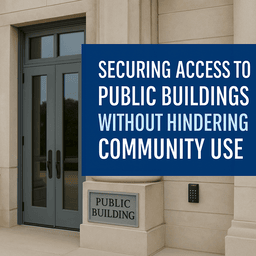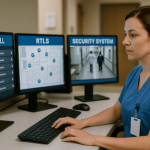
Balancing security and accessibility is a growing challenge for public sector leaders. City halls, libraries, recreation centers, and other municipal buildings must remain welcoming community spaces—yet also protect staff, infrastructure, and sensitive data from modern threats. This makes implementing secure access control for city buildings a critical, yet delicate task.
In this article, we’ll explore how municipalities can modernize their access control strategies to safeguard public buildings—without limiting the community’s ability to use them.
k
k
Why Traditional Access Models Fall Short
Historically, many public facilities have relied on physical keys, open doors during business hours, and limited entry logs. While these approaches support community accessibility, they create serious security blind spots:
-
Lost or copied keys can’t be revoked or tracked.
-
Open access during events increases risk of unauthorized entry into restricted areas.
-
No real-time monitoring means incidents are often detected too late.
As threats to public infrastructure grow—ranging from workplace violence to cybersecurity-linked physical breaches—municipalities must rethink how they manage access across all building types.
k
k
1. Adopt Tiered Access by Role and Function
Not every person needs access to every room.
By using role-based access control (RBAC), cities can grant building access based on job functions or community use cases. For example:
-
Public visitors can access lobbies, meeting rooms, and event spaces.
-
Employees can access administrative zones and secure records areas.
-
Only IT, police, or facilities staff can access server rooms or control systems.
Why it works: RBAC reduces the attack surface and allows granular control over who can go where—and when.
k
k
2. Implement Time-Based Access Scheduling
City buildings often host after-hours events, public meetings, and seasonal programming. Time-based access permissions allow for:
-
Scheduled unlocking/locking of doors during events.
-
Temporary credentials for visitors, vendors, and contractors.
-
Audit logs of every entry attempt—successful or not.
This level of control allows for flexibility without sacrificing visibility or accountability.
k
k
3. Enable Mobile and Cloud-Based Access Control
Modern access control systems no longer require bulky fobs or physical cards. Cities are increasingly turning to cloud-managed, mobile-enabled systems that offer:
-
Smartphone credentials for staff, board members, and temporary users.
-
Remote door locking/unlocking by administrators or dispatch centers.
-
Cloud-based management platforms accessible from any secure device.
Bonus: Mobile access cuts down on lost cards and key duplication risks.
k
k
4. Integrate Visitor Management Systems
Municipal buildings often serve a wide range of constituents. A robust visitor management platform enhances security while improving the user experience:
-
Pre-register visitors for public meetings or contractor access.
-
Print temporary badges with expiration dates and access limits.
-
Screen entries against watchlists or restricted lists where appropriate.
This creates a safer environment for both visitors and staff.
k
k
5. Preserve Openness with Transparent Security
Security shouldn’t feel oppressive to community members. SSP recommends design strategies that reinforce openness while enhancing protection:
-
Use clear signage to guide visitors and explain restricted areas.
-
Opt for discreet access control hardware that blends with architecture.
-
Install video intercoms at locked points to assist guests without compromising control.
When the community understands how and why access is managed, trust improves—and so does safety.
k
k
6. Ensure ADA and Equity Compliance
Any access control solution must be compliant with ADA (Americans with Disabilities Act) requirements and designed to support:
-
Touch-free options for accessibility.
-
Multilingual displays or voice prompts.
-
Equity across all age groups, physical abilities, and technical comfort levels.
SSP works closely with municipalities to ensure that security upgrades don’t exclude any members of the community.
k
k
7. Centralize Monitoring Across All Facilities
With multiple city-owned buildings, centralized visibility is key. An integrated access control platform lets you:
-
View all facility door statuses from a single dashboard.
-
Receive instant alerts when doors are propped open or forced.
-
Generate compliance reports and audit logs for budgeting or incident review.
Municipalities gain better insight—and better response capabilities—without the need for on-site monitoring at each location.
k
k
Building Safer, Smarter, More Welcoming Cities
Access control isn’t just about locking doors—it’s about managing how people move through public space in a way that protects both freedom and safety.
SSP helps government agencies design and implement tailored access control solutions that meet local needs, regulatory demands, and public expectations.
Whether you're retrofitting a historic courthouse or building a new community center, we ensure your public facilities remain open, secure, and future-ready.
🔐 Ready to Upgrade Access Control in Your City Buildings?
See how SSP helps government agencies protect their people and infrastructure.


